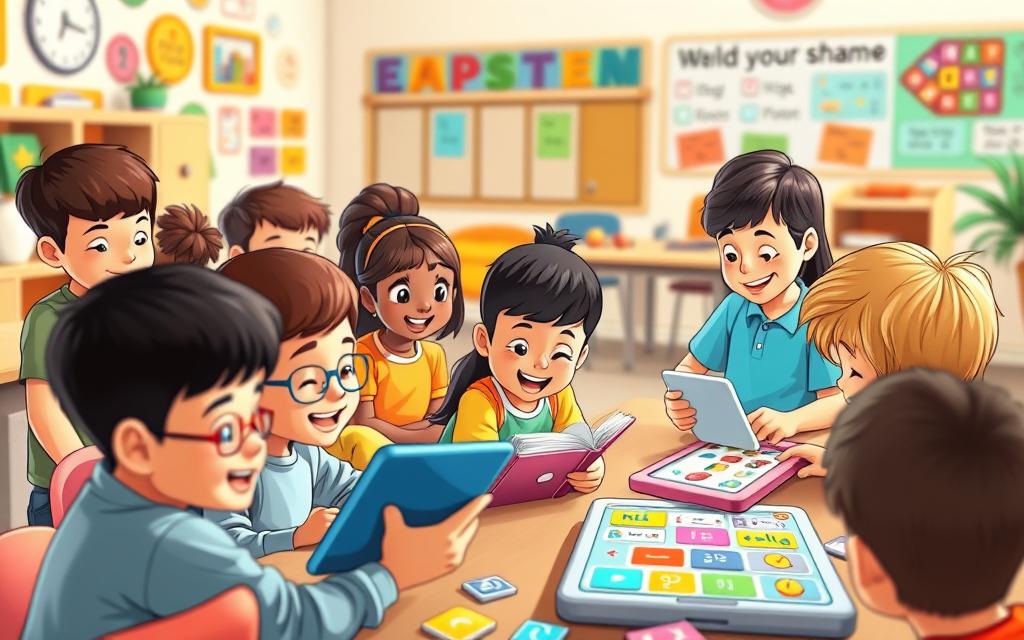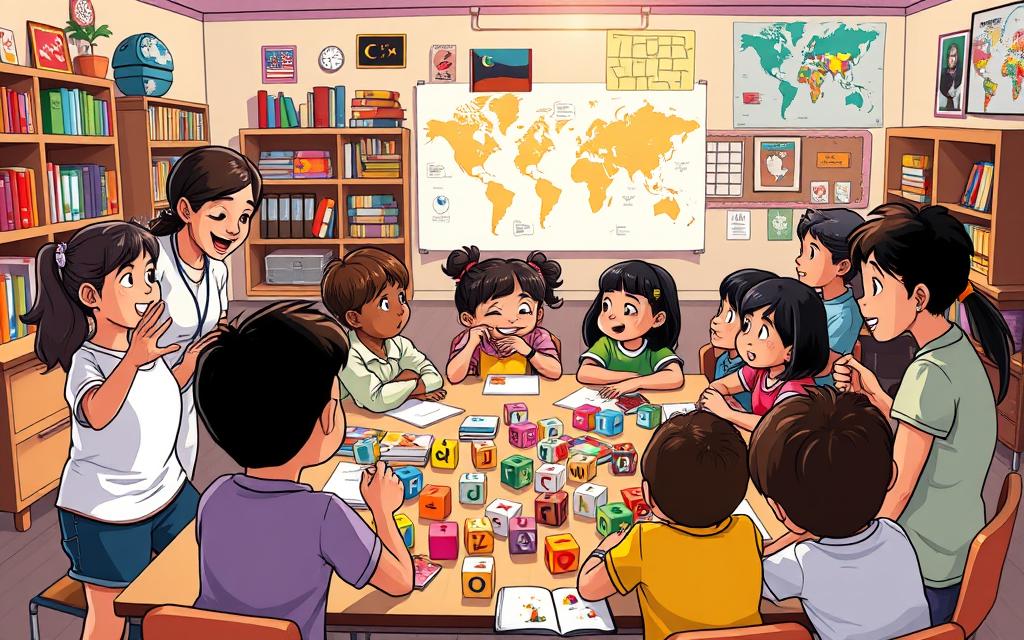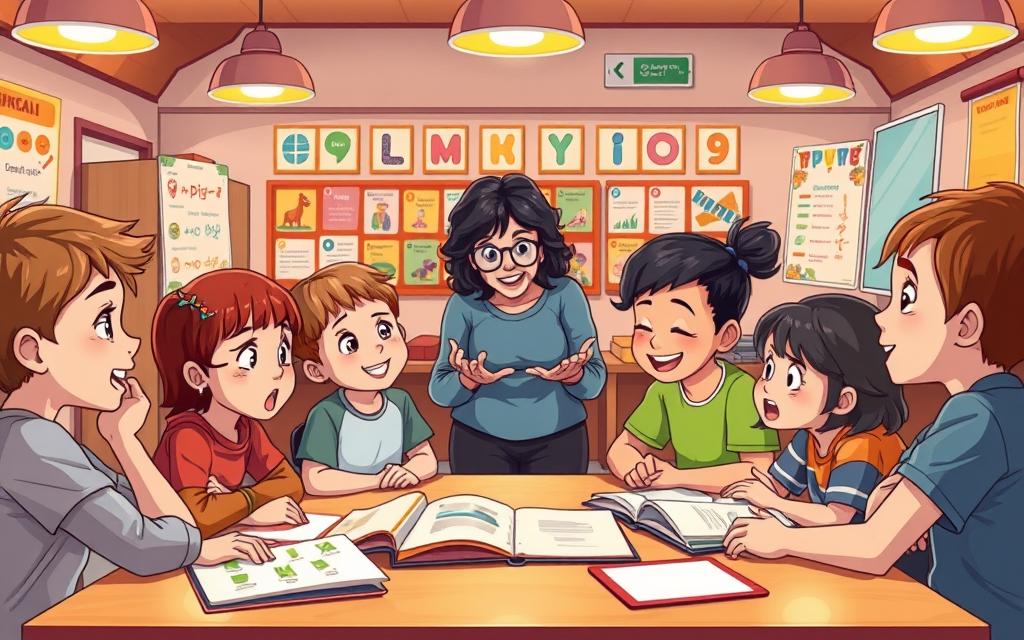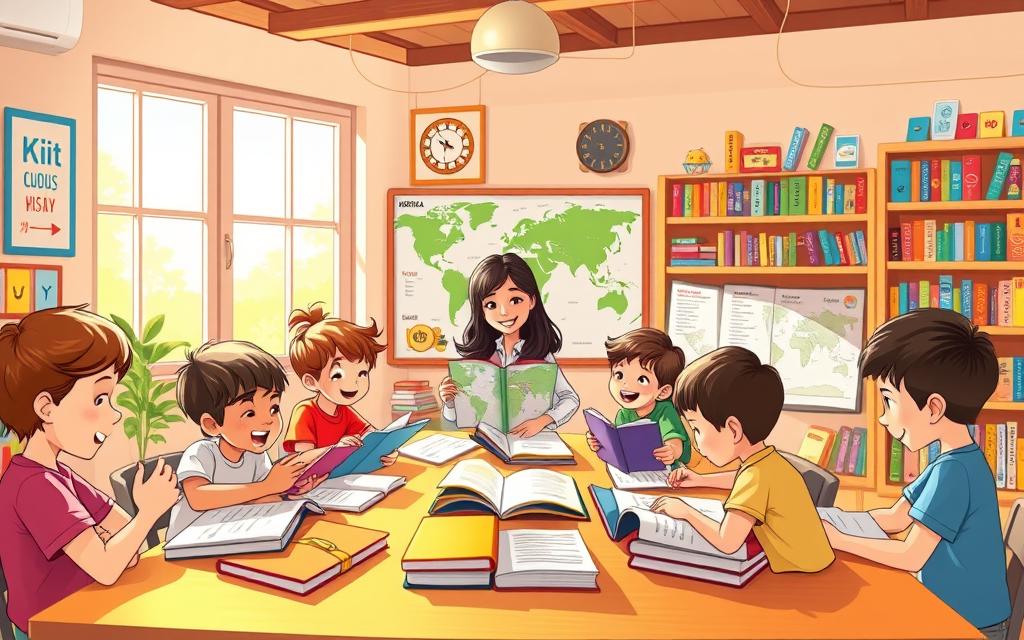Did you know only 20% of Americans can speak two or more languages? This shows how crucial it is to teach kids multiple languages early on. By starting early, you give your child a skill that will help them all their life. You can use different methods like speaking to them in various languages or making learning fun with games and activities, and learn more multilingual learning strategies for kids here.
As a parent, you’re key in helping your child learn languages. A supportive and fun learning space can make your child love learning and speaking multiple languages. It’s important to mix up skills like speaking, writing, reading, and listening to keep things interesting. Using games and making learning personal can also make it more exciting for your child.
The Power of Early Multilingual Education
By understanding the importance of multilingual learning strategies for kids, you equip your child with tools for lifelong success.
Thinking about your child’s education? You might wonder about bilingual education benefits. Early language learning is key for kids’ growth in many areas. It gives them a big advantage in life.
Why Multilingual Learning Matters for Kids
By implementing multilingual learning strategies for kids, you can create an environment where language learning feels natural and enjoyable.
✔ Boosts Brain Development – Multilingual children develop better memory, critical thinking, and multitasking abilities.
✔ Enhances Communication Skills – Speaking multiple languages improves social interactions and emotional intelligence.
✔ Expands Cultural Awareness – Learning different languages helps kids appreciate diverse traditions, stories, and customs.
✔ Provides Career and Academic Advantages – Multilingual individuals have higher job prospects and better academic performance in literacy and math.
Research shows bilingual kids do better in tasks that need planning and memory. They also learn new languages easily. This makes them more flexible and ready for the world’s changes.
- Improved cognitive flexibility and executive function
- Enhanced ability to learn new languages
- Increased cultural awareness and appreciation
- Better social and communication skills
As you explore various multilingual learning strategies for kids, consider incorporating storytelling and role-playing to enhance their engagement.
Choosing bilingual education early can boost your child’s future. It prepares them for a diverse and connected world.
Developing multilingual learning strategies for kids is crucial for enhancing their adaptability in diverse settings.
Utilizing these multilingual learning strategies for kids will help shape their educational journey and empower them for future challenges.
Create an Immersive Language Environment at Home
To help kids learn multiple languages, make your home a language-rich space. Use real materials like books and videos in the target language. Set up a language corner with books, games, and puzzles in many languages. This should be clutter-free, easy to navigate, and visually appealing for your child.
Implementing effective multilingual learning strategies for kids is essential for their cognitive and social development. By using specific multilingual learning strategies for kids, parents can enhance their children’s language acquisition process.
Effective tools for kids include language apps, online programs, and educational videos. These can boost their language skills and keep them interested. By using these tools daily, your child will build a strong language foundation. This can improve their thinking and school performance.
Here are some tips for making your home a language-rich environment:
Utilizing multilingual learning strategies for kids can facilitate their ability to connect with peers from different backgrounds.
These multilingual learning strategies for kids ensure they receive a well-rounded education that includes cultural awareness and appreciation.
In this ever-connected world, multilingual learning strategies for kids play a significant role in shaping their future opportunities. Embracing these strategies will help children navigate diverse environments more efficiently.
- Use language learning apps and online programs to supplement your child’s language education
- Create a language learning corner in your home with books, games, and puzzles in multiple languages
- Watch educational videos and TV shows in the target language with your child
- Encourage your child to speak in the target language during daily activities, such as mealtime and bedtime routines

By following these tips and using the right tools, you can help your child become proficient in multiple languages. This can enhance their thinking, school success, and future career options.
Effective Multilingual Learning Strategies for Kids
Supporting your child’s language growth is key. Using play, games, and music can make learning fun. This approach helps them grow in many ways.
Studies show that games make learning more exciting. Apps with puzzles can make learning a game. Games that focus on listening and speaking help improve skills.

- Use sentence frames, visual aids, and posted vocabulary to support language development
- Encourage collaborative learning through think-pair-share variations and group activities
- Provide chances for students to clarify concepts in their first language
- Integrate tangible or virtual manipulatives to enhance engagement in math education
Multilingual learning strategies for kids include immersive experiences that foster engagement with different languages and cultures. These experiences can be integrated into daily routines.
By using these methods, your child can learn many languages. This will help them love learning for life.
Incorporating multilingual learning strategies for kids can significantly boost their confidence in using multiple languages.
Technology Tools and Digital Resources
Exploring multilingual learning strategies for your child? Technology plays a big role in language learning. There are many digital tools that make learning fun and effective. Language acquisition techniques can be boosted by apps, online programs, and virtual exchanges.
Implementing these multilingual learning strategies for kids will not only help them in academics but also in building social connections in a multicultural world.
Choosing a good language program is key. It should use many learning methods. Technology offers benefits and challenges. For example, apps can make learning interactive, while online programs offer a structured way to learn.
These multilingual learning strategies for kids can also be adapted based on their interests and learning styles for maximum effectiveness.
Here are some examples of tech tools and digital resources:
- Educational apps, like Duolingo and Babbel, offer interactive lessons and exercises.
- Online language programs, such as Rosetta Stone and LanguagePod101, provide a structured learning approach.
- Virtual language exchange sites, like italki and Conversation Exchange, connect learners with native speakers for practice.

Using these tools can help your child learn languages better. It gives them an edge in today’s world. Pick tools that fit your child’s learning style and goals. Try different options until you find the best ones.
Build Daily Language Routines
Starting your bilingual education journey means setting up daily language routines. These routines are vital for early language growth. They include reading, writing, and speaking activities. For example, spend 30 minutes daily on language learning.
Try reading bilingual books, writing in a journal, or talking with a language partner. This helps a lot.
Tracking your progress is also important. It makes sure you’re learning well. Daily routines help create a supportive learning space. Here are some tips:
- Make a language learning schedule and follow it.
- Set goals and keep track of how you’re doing.
- Do different activities like reading, writing, and speaking.

By following these tips, you can help your child learn many languages well.
Remember, being consistent and repetitive is key. Find a daily routine that fits you and your child. With the right approach, your child will do great in learning languages.
Incorporate Cultural Elements into Language Learning
Creating a well-rounded language learning experience for kids means adding cultural elements. This helps promote language diversity in schools. By introducing kids to different cultures, you boost their language skills and broaden their world view.
Introducing kids to various cultural practices and traditions is key. This makes learning a language more meaningful. Activities like sharing stories, celebrating cultural events, and exploring international music and arts are great ways to do this.
These activities make learning fun and personal. They help kids connect with the language on a deeper level. This way, you’re not just teaching a language, but also promoting cultural understanding.

By focusing on both language and culture, kids get a strong foundation. They learn to appreciate the language’s cultural significance. This leads to a deeper understanding of the language and its nuances.
Supporting Multilingual Development Through Social Interaction
Supporting your child’s multilingual growth is key. Social interaction plays a big role in learning languages. By using different strategies, you can help your child learn through talking and playing with others.
For example, joining language exchange programs can be very helpful. It lets your child talk with native speakers. This boosts their language skills and how well they can communicate.
Studies show that role-playing and games can improve language skills. The same goes for kids learning languages. Talking with native speakers helps them get better at speaking, listening, reading, and writing in different languages.

There are many ways to help your child learn languages. Language learning communities, social media groups, and online forums are great. They let kids practice their language skills and share their experiences.
Encouraging your child to take part in oral history projects is also good. It helps them use their language skills to share their cultural knowledge and identity. This way, your child can become proficient in multiple languages, ready for the global world.
Overcome Common Challenges in Multilingual Learning
Understanding and applying multilingual learning strategies for kids can make a significant difference in their language acquisition journey. Learning multiple languages has many benefits, but it comes with challenges. Parents and teachers face issues like managing language mixing, dealing with resistance, and keeping things consistent. These are important to tackle.
Navigating Language Mixing
Young learners often mix languages as they get better. This is a normal part of learning. Use this chance to teach the unique sounds, words, and rules of each language.
Addressing Resistance
Some kids might not want to learn many languages. They might feel shy or find it hard to keep up. Be patient and positive. Show them how being multilingual is an advantage.
Maintaining Consistency
Regular practice and exposure are vital for learning multiple languages. Create a daily routine for language learning. Work together at home and school. With effort and support, your child will do well.
By emphasizing multilingual learning strategies for kids, you can cultivate their passion for language and culture from an early age.
Multilingual Learning Strategies for Kids: Unlock Their Potential
Focusing on multilingual learning strategies for kids will ensure they develop essential skills for communication and understanding in a globalized world. And encouraging multilingual learning strategies for kids within the home and educational settings is vital for their linguistic development.
1. Create a Language-Rich Environment
Children learn best when they are surrounded by the target language(s). Exposure and immersion play key roles in making a language feel natural.
How to Implement:
✅ Label objects around the house in multiple languages (e.g., table = mesa (Spanish), table (French)).
✅ Play music, audiobooks, and stories in different languages.
✅ Use bilingual books or dual-language storybooks.
✅ Incorporate TV shows, cartoons, and movies in different languages.
✅ Set up a language corner with flashcards, posters, and interactive learning tools.
Why It Works:
✔ Provides constant exposure to different languages.
✔ Helps kids associate words with real-life objects.
✔ Encourages passive learning without pressure.
2. Follow the One Person, One Language (OPOL) Method
The OPOL method is a popular approach where each parent (or teacher) consistently speaks one language to the child.
How to Implement:
✅ One parent speaks only Spanish, while the other speaks only English at home.
✅ A teacher speaks only French, while the school environment is in English.
✅ A caregiver or nanny interacts with the child exclusively in Mandarin.
Why It Works:
✔ Helps children distinguish between languages without confusion.
✔ Builds consistent language patterns for natural communication.
✔ Encourages equal exposure to each language.
Alternative Approach:
If OPOL is difficult to implement, try Minority Language at Home (MLAH)—where the family speaks the minority language at home while the child learns the dominant language in school.
3. Play-Based Language Learning
Children learn best through play, making it one of the most effective ways to reinforce multiple languages.
Fun Learning Activities:
🎲 Board Games: Use bilingual games like Scrabble, Boggle, or memory match.
🎭 Role-Playing: Pretend-play scenarios like a restaurant, doctor’s office, or travel experience.
🎤 Sing Songs & Rhymes: Use nursery rhymes, action songs, and karaoke in different languages.
📖 Storytelling: Let kids create stories using words from different languages.
🎨 Art & Crafts: Label drawings and creations in multiple languages.
Exploring this approach will provide children with enriched multilingual learning strategies for kids that can adapt to their interests and needs.
Why It Works:
✔ Makes language learning fun and natural.
✔ Enhances listening, speaking, and reading skills.
✔ Encourages repetition and reinforcement.
4. Encourage Daily Conversations in Different Languages
Using a language in everyday situations is key to making it second nature for kids.
How to Implement:
✅ Have daily conversations in different languages depending on the setting. (e.g., Breakfast in English, Playtime in Spanish, Storytime in French.)
✅ Set themed language days (e.g., “Monday is Mandarin day!”).
✅ Encourage children to ask for things using complete sentences in the target language.
✅ Use question-and-answer games in different languages (e.g., “What did you eat today?”).
Why It Works:
✔ Helps kids develop confidence in speaking.
✔ Reinforces practical vocabulary.
✔ Creates consistent exposure and usage.
5. Use Multilingual Apps & Digital Resources
Technology can be a powerful tool for helping kids learn and practice multiple languages in an engaging way.
Top Language Learning Apps for Kids:
📱 Duolingo Kids – Fun, game-like lessons for beginners.
📱 Gus on the Go – Interactive vocabulary-building games.
📱 Endless Spanish/French/Mandarin – Teaches through animated storytelling.
📱 LinguPinguin – Perfect for toddlers learning new words.
📱 Little Pim – A multimedia program using short video lessons.
Why It Works:
✔ Provides interactive and self-paced learning.
✔ Uses visual and auditory reinforcement.
✔ Encourages consistent practice in a fun way.
6. Foster a Multicultural Mindset
Language learning isn’t just about words—it’s about culture and connection. Encouraging a love for different cultures helps children stay motivated to learn new languages.
How to Implement:
🌎 Celebrate international holidays and traditions (e.g., Chinese New Year, Día de los Muertos).
🍜 Cook foods from different cultures while discussing the ingredients in the native language.
🎭 Watch cultural performances, dances, and movies in the target language.
🖼 Visit museums, cultural festivals, or international events.
📖 Read folk tales and legends from different countries.
Why It Works:
✔ Increases interest and appreciation for the language.
✔ Helps kids develop a global perspective.
✔ Connects language learning with real-world experiences.
7. Travel or Virtual Language Immersion
Experiencing a language in real-life settings strengthens language skills significantly.
How to Implement:
✈ Travel to countries where the language is spoken.
📞 Arrange video calls with native speakers (family members, pen pals, tutors).
🎤 Enroll in language immersion programs or summer camps.
🌎 Join multilingual playgroups or community language classes.
Why It Works:
✔ Builds real-world communication skills.
✔ Provides full immersion in a language-rich environment.
✔ Makes language learning feel useful and exciting.
8. Be Patient and Make It Fun!
Multilingual learning should be a positive experience—kids should never feel pressured or overwhelmed.
Encouragement Strategies:
✅ Praise their efforts, even if they make mistakes.
✅ Use games, songs, and activities to make learning enjoyable.
✅ Avoid comparing their progress to others—each child learns at their own pace.
✅ Keep it low-pressure—if a child resists, switch to a different learning approach.
Why It Works:
✔ Keeps children motivated and engaged.
✔ Reduces language anxiety.
✔ Creates a lifelong love for learning languages.
Unlocking a child’s multilingual potential is a journey filled with excitement, creativity, and cultural exploration. By combining immersion, play-based learning, structured exposure, and cultural appreciation, children can develop fluency in multiple languages naturally and joyfully. With the right multilingual learning strategies for kids, you can create lasting memories and experiences while they learn languages.
Start small, be consistent, and most importantly—make it fun!
Key Takeaways
- Introducing multilingual learning strategies for kids from a young age can have a significant impact on their language development.
- Language acquisition techniques, such as speaking to your child in multiple languages from birth, can help develop multilingual skills.
- Creating a supportive and engaging learning environment is crucial for fostering a love for learning and language development.
- Multilingual learning strategies for kids can involve incorporating multiple skills, such as speaking, writing, reading, and listening.
- Effective language acquisition techniques, such as gamification and personalized learning, can increase learners’ interest and motivation.
- Parents play a significant role in shaping their child’s language development and can help their child develop valuable multilingual skills.
Source Links
- Learner Experience: The Key to Successful Language Learning – https://preply.com/en/blog/b2b-learner-experience-language-learning/
- Why AI Is a Game-Changer for E-Learning – https://www.articulate.com/blog/why-ai-is-a-game-changer-for-e-learning/
- The Role of AI in EdTech for Personalized Learning Experiences – https://agilityportal.io/blog/the-role-of-ai-in-edtech-for-personalized-learning-experiences
- Bilingualism in Early Childhood Education – Teachersguide – https://teachersguide.net/bilingualism-in-early-childhood-education/
- How Schools Can Expand Dual-Language Immersion Programs – https://www.edweek.org/teaching-learning/how-schools-can-expand-dual-language-immersion-programs/2025/02
- Multilingual Education – Multilingual Learners (CA Dept of Education) – https://www.cde.ca.gov/sp/ml/multilingualedu.asp
- Boost Your Child’s Brainpower: The Gift of Multilingualism — A Parent’s Guide – https://homeschoolmagazine.com/2025/02/boost-your-childs-brainpower-the-gift-of-multilingualism-a-parents-guide/
- Nursery Curriculum UK: What Parents Should Know – https://www.hatching-dragons.com/en-gb/blog/nursery-curriculum-uk-what-parents-should-know-1
- English Language Learners (ELLs) – https://heartandart.ca/category/english-language-learners-ells/
- Use Games and Interaction to Support Multilingual Learners – https://www.middleweb.com/46362/fun-ways-to-support-multilingual-learners/
- Ways to Support Multilingual Learners – Literacy Partners – https://literacypartners.com/ways-to-support-multilingual-learners/
- Raising multilingual and bilingual children: options – https://raisingchildren.net.au/babies/connecting-communicating/bilingualism-multilingualism/raising-bilingual-children-tips
- Resources for Closing the Digital Divide – https://www.edutopia.org/digital-divide-technology-access-resources
- K-12 Tech Solutions That Actually Close the Digital Divide – Teach Find – https://teachfind.com/uncategorized/k-12-tech-solutions-that-actually-close-the-digital-divide/
- 4 Ways to Plan for the Success of Newcomer ELLs – https://www.edutopia.org/article/4-ways-plan-success-newcomer-ells/
- 6 Picture Books to Help Newcomer Students Build a Sense of Belonging – https://www.edutopia.org/article/building-students-sense-belonging-picture-books/
- Category: Literacy – https://cpet.tc.columbia.edu/news-press/category/literacy
- Strategies That Help Multilingual Students Learn Content and English at the Same Time – https://www.edutopia.org/article/teaching-ells-content-english-simultaneously/
- Integrating Language Learning into Early Education: Best Practices for Educators and Parents – https://www.safesearchkids.com/integrating-language-learning-into-early-education/
- Scaffolding for Experienced English Language Learners – https://www.edutopia.org/article/helping-experienced-multilingual-learners/
- The Benefits of Oral History Projects for Multilingual Learners – https://www.edutopia.org/article/benefits-oral-history-projects-multilingual-learners/
- Dual Language Immersion (DLI) Program – https://www.cde.ca.gov/sp/ml/edgedli.asp
- Integrating classroom assessment to enhance language development – https://wida.wisc.edu/news/integrating-classroom-assessment-enhance-language-development
- English Language Development Standards – Multilingual Learners (CA Dept of Education) – https://www.cde.ca.gov/sp/el/er/eldstandards.asp
- The New Teachers’ Aides: AI Tutors – https://www.edweek.org/technology/the-new-teachers-aides-ai-tutors/2025/02



